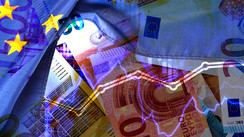Prelude to the Unprecedented Fall
The year 2020 will forever be engraved in the annals of financial history. As the world grappled with an unprecedented global pandemic, the stock market plummeted, generating ripples of panic among investors worldwide. Let's set the stage to understand how the financial drama unfolded.
The Calm Before the Storm
The stock market was riding high in the first few weeks of the year. Everything was business as usual until the middle of February. On February 12, the Dow Jones Industrial Average (DJIA) hit a historic peak, scaling to an all-time high of 29,551.42 points. The financial world was jubilant, completely unaware of the tempest that was brewing.
The Onset of the Crisis
Then, on March 9, a day that would later be known as "Black Monday 2020," the global financial markets came crashing down. The DJIA recorded the largest point drop in its history, an event that sent shockwaves throughout Wall Street. Investors held their breath as the stock market began to shake violently under the weight of escalating global uncertainties.
The Looming Threats
The triggers of this extraordinary fall were manifold:
-
Global Health Crisis: The escalating COVID-19 pandemic generated a climate of anxiety and fear around the world. The uncertainty surrounding the virus's potential impact fueled a sense of impending doom that seeped into the global markets.
-
Oil Prices: Oil prices were tumbling, sparking concerns about an economic slowdown. The unanticipated price war between oil giants Saudi Arabia and Russia sent oil prices into a freefall, adding more fuel to the financial firestorm.
-
Economic Downturn Speculations: Speculation about a potential economic recession was rife. The financial pundits were filled with grim predictions, further exacerbating the market's dire state.
The Immediate Aftermath
The days following March 9, particularly March 12 and March 16, were marred by additional record-shattering declines. However, even amidst this financial chaos, a tale of resilience was slowly taking shape. Despite the devastation, the stock market, in the face of adversity, began to pick itself up. It would rally, demonstrating an unanticipated recovery, even as various sectors of the American economy grappled with the pandemic's impact.
This resilience displayed by the markets in 2020 is an eloquent testament to the inherently unpredictable and volatile nature of the global financial system, a reminder of its power to surprise us, even in times of unprecedented crisis.
A Retrospective Look at the 2020 Market Crash
Retracing the steps of the financial calamity of 2020 provides us with important lessons and insights. Let's explore how the whirlwind of events unfolded, causing shockwaves that reverberated throughout the global economy.
The Tumbling Dominoes
Post the 'Black Monday 2020,' the Dow spiraled downwards at an alarming pace. From its zenith on February 12 to March 16, it shed a staggering 9362.90 points, culminating in a terrifying decline of 31.7%. This downturn was neither slow nor gentle; it was akin to free-falling from a cliff, eliciting gasps of disbelief and dread.
A Bear Market is Born
By March 11, the Dow had plummeted 20.3% from its February 12 high, sparking the birth of a bear market. The bull market, which had been in charge since March 2009, was unceremoniously dethroned, ushering in a grim period of financial uncertainty.
Record-Breaking Slides
On the heels of Black Monday, the Dow nosedived by 2,352.60 points on March 12, closing at 21,200.62 – a near 10% drop in a single day. The financial world watched in stunned silence as the markets slipped towards chaos.
The turmoil wasn't over. March 16 brought another devastating blow. The Dow plunged another 2,997.10 points to close at 20,188.52, marking the worst single-day point drop in U.S. market history.
Comparisons with Historical Market Crashes
The 2020 crash was a seismic event, shaking the very pillars of the global financial system. But it was not without precedents. Here's how the 2020 debacle compares to the infamous 'Black Mondays' of yesteryears.
The 1987 Crash
Before the March 16, 2020 crash, the worst had been Black Monday, October 19, 1987. On this ill-fated day, the Dow plunged a massive 22.6%, sending shockwaves around the globe. The magnitude of the drop dwarfed anything that had been witnessed in modern financial history.
The 1929 Crash
The Black Monday of October 28, 1929, saw the Dow losing nearly 13%, marking the onset of the Great Depression, a bleak period in financial history that cast a long shadow over the global economy for years.
The 2020 crash was distinct in its causes, impacts, and speed of recovery. Driven by a unique combination of factors, including a global health crisis and the ensuing economic shutdown, it stands as a unique chapter in the annals of financial history. The comparison with the previous Black Mondays underscores the uniqueness of the 2020 financial debacle, reminding us of the importance of context and circumstance in shaping market behaviors.
Repercussions of the Crash
The 2020 market crash did not merely rearrange the landscape of stock indices; it unleashed an array of economic ripple effects, some predictable, others less so. Let's delve into the far-reaching consequences of this extraordinary financial event.
The Birth of a Recession
Stock market crashes are notorious for spawning recessions, and 2020 was no exception. The effects of the crash, amplified by a global pandemic and an inverted yield curve, a phenomenon often seen as a harbinger of a recession, combined to create a perfect economic storm. As short-term Treasury bill returns exceeded those of the 10-year note, the financial world shuddered in apprehension.
Echoes in the Bond Market
In the aftermath of the crash, investors sought sanctuary in bonds, pushing yields to historic lows. This flight to safety underscored the pervasive anxiety and uncertainty sweeping across the financial landscape. The yield curve inversion, a rare situation that signaled greater short-term risk than long-term, was a warning bell that could not be ignored.
A Bear Market of Unusual Length
Bear markets, on average, persist for 22 months, but some conclude within as few as three months. The 2020 recession was followed by an unexpected stock market boom in the summer and fall. By the end of November 2020, the Dow had rocketed past the 30,000 points threshold, a testament to the resilience and adaptability of markets.
Impact on Investors and Workers
The tumult of 2020 left an indelible mark on the lives of investors and workers alike, reshaping their financial landscape in ways that continue to reverberate.
Investors' Perseverance
The resilience displayed by investors during and after the crash was remarkable. Despite the daunting economic backdrop, many held their nerve, continuing to invest instead of liquidating their holdings. Their steadfastness proved crucial in boosting the market's recovery speed, pushing the Dow and S&P 500 to new highs in early 2022.
The Fed Steps In
The Federal Reserve intervened to soothe the volatile markets, slashing its target rate range for federal funds to zero in March 2020. As a result, the cost of auto, school, and home loans tumbled, making these debts cheaper for consumers in 2020 and 2021.
The Disparity in Gains
However, the gains from the market rally and low-interest rates were not evenly spread across society. The soaring stock market painted a somewhat misleading picture of the broader economy, masking pockets of hardship and distress. Despite the impressive market performance, not all workers reaped the benefits.
The Struggle of the Workers
Unemployment skyrocketed in the sectors most affected by the pandemic, like hospitality and childcare. Unemployment surged from 3.5% in February to a distressing 14.7% by April 2020. While the job market recovered in the subsequent years, it was not until March 2022 that the national unemployment rate finally fell to 3.6%. This disparity underlines that a thriving stock market does not always equate to a healthy economy for all its participants.
Measures to Curtail the 2020 Recession
The economic turbulence of 2020 necessitated robust measures from the federal government, both under President Trump and President Biden. A host of actions were taken to stave off a deepening recession and hasten recovery, each tailored to mitigate the economic damage in various sectors.
Policy Interventions
The authorities responded with a series of strategic maneuvers, including:
-
Targeted Aid: Funds were directed towards the most severely hit sectors of the economy, offering a lifeline to businesses grappling with the dual threats of a pandemic and recession.
-
Direct Cash Payments: Money was put directly into taxpayers' pockets to boost consumer spending and provide much-needed relief for families feeling the financial pinch.
-
Enhanced Unemployment Insurance: The safety net for the unemployed was reinforced, giving added support to those who found themselves without work in the middle of a public health crisis.
-
Rental Assistance: Renters bearing the brunt of the economic turmoil were offered aid to prevent mass evictions and further destabilization of the housing market.
Vaccine Rollout: A Light at the End of the Tunnel
The swift development and deployment of multiple COVID-19 vaccines brought hope to the beleaguered markets. President Biden's directive in March 2021 to make all adults eligible for the vaccine by May 1 further bolstered investor confidence.
Stock Market Resilience
Against the backdrop of an unparalleled crisis, the stock market exhibited extraordinary resilience. The unique blend of stimulus measures, combined with accelerated vaccine development and distribution, provided a much-needed boost to investor confidence.
The 2020 stock market crash was shaped by unprecedented circumstances. Yet, it also showcased the enduring strength and adaptability of markets, underscoring the critical role of strategic policy decisions and technological advancements in financial recovery. As we look back, the events of 2020 serve as a powerful reminder of the market's ability to recover, even from the most devastating of blows.





